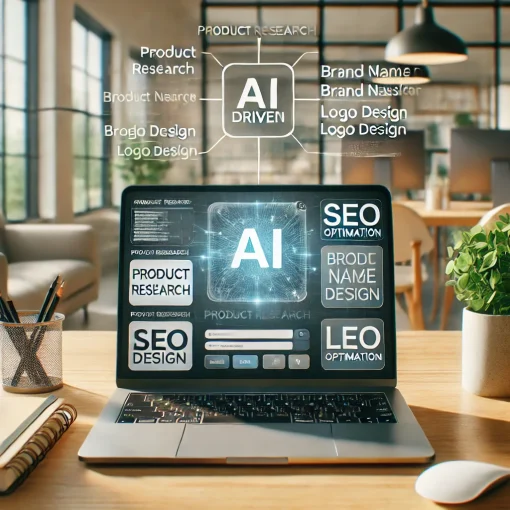Revolutionize Your Online Store: How AI Tools Can Transform Your E-Commerce Strategy
In the highly competitive world of e-commerce, harnessing the power of artificial intelligence (AI) can provide a significant advantage. AI technology offers a range of tools designed to streamline operations, enhance efficiency, and drive profitability. From product research to customer engagement, AI can automate and optimize many critical aspects of running an online store.
However, despite its capabilities, AI cannot replace the human touch in certain areas. This article provides a step-by-step guide on how to use AI to develop your e-commerce business, detailing the tasks AI can handle and those that still require manual input. Whether you’re a seasoned entrepreneur or just starting out, understanding how to effectively integrate AI into your e-commerce strategy can help you build a successful and thriving business.
Step 1: Market and Product Research
What AI Can Do:
- Identify High-Demand Products: AI tools can analyze market trends and consumer data to identify products with high sales potential and low competition. Platforms like Algopix and Jungle Scout use AI to provide insights into product demand, pricing, and competition.
- Analyze Competitor Strategies: AI-driven tools such as SEMrush and Ahrefs can analyze your competitors’ websites to uncover their top-performing products, keywords, and marketing strategies.
What Needs to Be Done Manually:
- Final Decision Making: While AI can provide a list of potential products, the final decision on which product to sell should be based on your personal knowledge of the market and your business goals.
Step 2: Creating a Brand Identity
What AI Can Do:
- Generate Brand Names: AI tools like Namelix and BrandBucket can generate unique and relevant brand names based on your business niche and preferences.
- Design Logos: Platforms such as Looka and Tailor Brands use AI to create professional logos that reflect your brand’s identity and values.
What Needs to Be Done Manually:
- Brand Personality Development: Crafting the brand’s voice, mission, and values is a creative process that requires human intuition and understanding of the target audience.
- Final Approval: Choosing the final brand name and logo design involves subjective judgment that AI cannot replicate.
Step 3: Building the Online Store
What AI Can Do:
- Website Design and Layout: AI-powered website builders like Wix ADI and Bookmark can design your website layout, structure, and even suggest content placements based on user behavior analysis.
- Personalized User Experience: AI tools can personalize the shopping experience by recommending products based on user behavior and preferences. Shopify and Magento offer AI-driven personalization features.
What Needs to Be Done Manually:
- Content Creation: Writing product descriptions, blog posts, and other content is best done by humans to ensure it resonates with the target audience.
- Customization: Fine-tuning the website’s look and feel to align with the brand identity requires human creativity and attention to detail.
Step 4: Search Engine Optimization (SEO)
What AI Can Do:
- Keyword Research: AI tools like SEMrush and Ahrefs can identify the most effective keywords to target, helping you optimize your product listings and content for search engines.
- Content Optimization: AI-powered platforms like Clearscope and SurferSEO can analyze your content and suggest improvements to enhance its SEO performance.
What Needs to Be Done Manually:
- Content Writing: Creating high-quality, engaging, and unique content is a task that requires human creativity and expertise.
- Strategy Planning: Developing a comprehensive SEO strategy that aligns with your business goals and target audience requires human insight and strategic thinking.
Step 5: Marketing and Customer Engagement
What AI Can Do:
- Email Marketing: AI tools like Mailchimp and Sendinblue can automate email marketing campaigns, segment your audience, and personalize email content to increase engagement.
- Social Media Management: Platforms like Hootsuite and Buffer use AI to schedule posts, analyze engagement metrics, and suggest the best times to post.
- Chatbots: AI-driven chatbots like Drift and Chatfuel can handle customer inquiries, provide instant responses, and improve customer service efficiency.
What Needs to Be Done Manually:
- Creative Campaign Development: Developing innovative and impactful marketing campaigns requires human creativity and a deep understanding of the target audience.
- Customer Relationship Management: Building genuine relationships with customers, addressing complex issues, and providing personalized support are tasks that benefit from the human touch.
Step 6: Data Analysis and Improvement
What AI Can Do:
- Analytics and Reporting: AI tools like Google Analytics and IBM Watson Analytics can process vast amounts of data to provide insights into customer behavior, sales trends, and marketing performance.
- Predictive Analytics: AI can forecast future trends, helping you make data-driven decisions to improve your business strategy.
What Needs to Be Done Manually:
- Interpretation and Action: While AI can provide valuable insights, interpreting these insights and deciding on the best course of action requires human judgment and experience.
- Continuous Improvement: Implementing changes based on data analysis and continuously improving your business operations is an ongoing process that benefits from human oversight.
Conclusion
In the dynamic and ever-evolving world of e-commerce, leveraging AI technology can be a game-changer for your business. By incorporating AI-driven tools for product research, brand identity creation, website building, SEO, marketing, and data analysis, you can streamline operations, enhance efficiency, and ultimately boost profitability.
AI excels in identifying high-demand products, generating brand names, designing logos, optimizing keywords, and personalizing customer experiences. However, the human touch remains essential for final decision-making, content creation, strategy planning, and building genuine customer relationships. By blending the strengths of AI with human creativity and insight, you can develop a successful and competitive e-commerce business.
Embrace the power of AI and transform your e-commerce strategy to stand out in today’s crowded digital marketplace. Unlock the potential of AI tools to propel your e-commerce business to new heights, ensuring sustainable growth and success in the long term.
Check out my article The Power of AI in E-Commerce: A New Era for Retail


